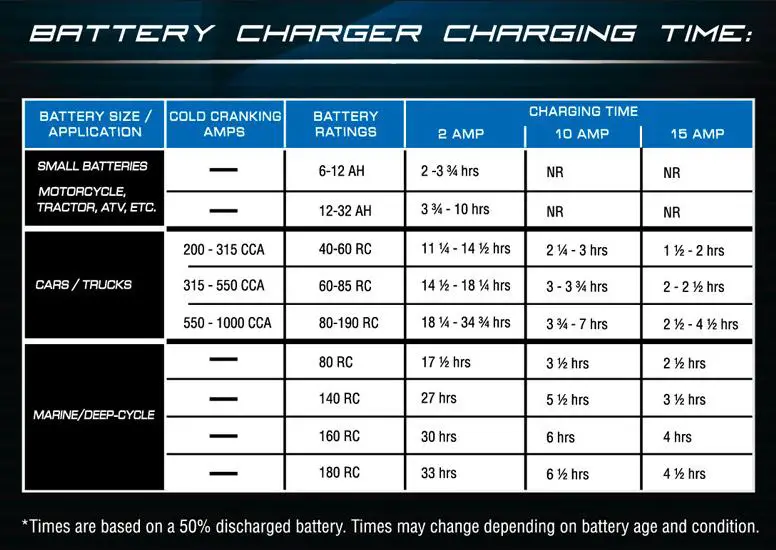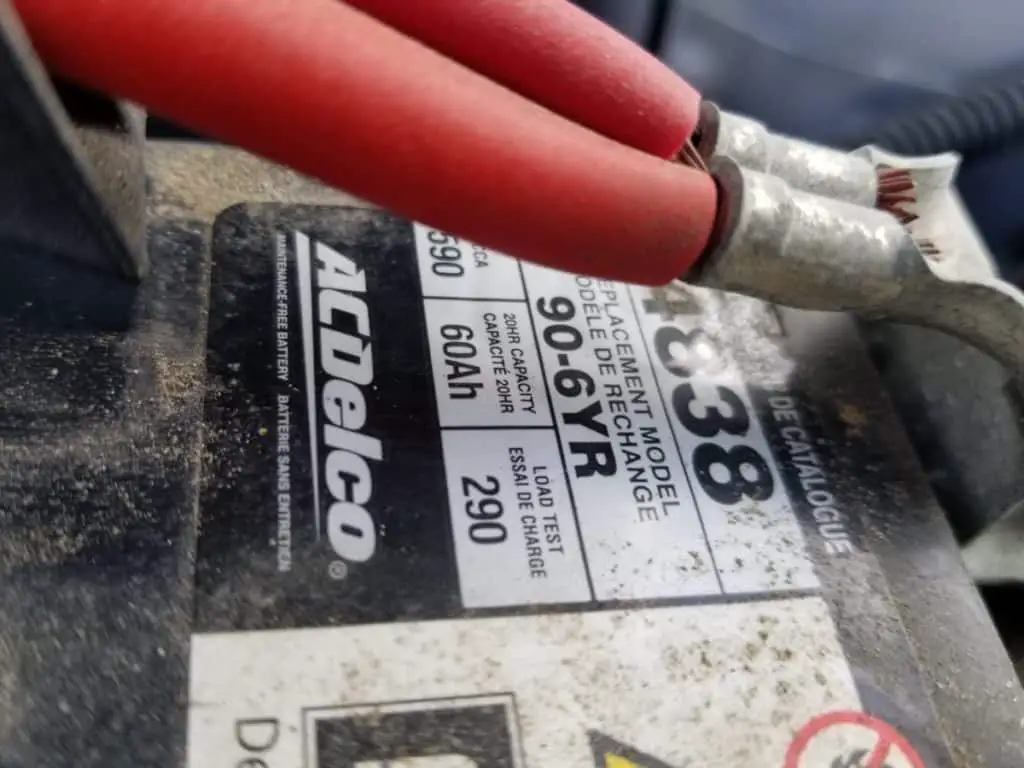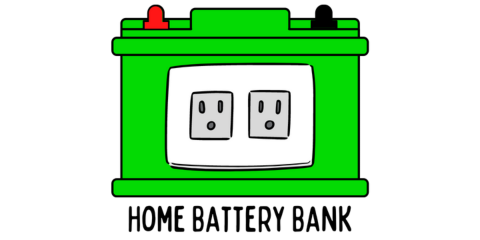That 40-pound car battery under your hood is generally rated in cold cranking amps — not amp-hours. It has a lot of energy but it is best at delivering that energy in small but high amperage bursts.
If you’re in a pinch and don’t have a marine or deep-cycle battery around, you might find yourself wondering just how many amps (amp hours) a car battery has to power something.
Small car batteries are around 40 amp-hours. Mid-sized batteries for larger cars and SUVs are around 50 amp-hours. Larger vehicles, such as trucks, can have batteries around 75 amp-hours.
Typically, car batteries are rated in CA or CCA (Cranking Amps, or Cold Cranking Amps) and not in AH (Amp Hours) like a deep cycle battery for powering appliances or electronics.
There is no hard-and-fast rule for converting amp hours to cranking amps or cold cranking amps (or vice versa). It would be like trying to compare the efficiency of one car by seeing how one can go from zero to 60mph with another car by using average miles per gallon.
Maybe you can draw a few correlations but correlations do not mean causation.
Still, that didn’t stop me from doing some research to see if we could get a relatively comfortable ballpark estimate of a car battery’s relationship between the two.
I’m going to cover how many amp-hours a car battery is estimated to have based on its Cold Cranking Amps, why car batteries are rated in Cold Cranking Amps and not amp-hours, and how many amps it takes to charge a battery up.
Feel free to open this in a new tab to access my easy to use calculators to figure out how long it will take you to charge any car battery with any charger.
Here’s How Many Amps are in a Car Battery
Amp Hour Estimates Based On Cold Cranking Amps or Reserve Capacity
| If Your Sticker Reads: 200-315 CCA, or 40-60 RC | If Your Sticker Reads: 315-550 CCA, or 60-80 RC | If Your Sticker Reads: 550-1,000 CCA, or 80-190 RC |
| 36 - 46.2 AH | 46.2 - 58.8 AH | 58.8 - 111 |
This is the chart I came up with after I studied the charging time data provided by Schumacher, a battery charger manufacturer.
In their charts, they give the estimated charging times for different types of batteries based on different amps being delivered from the chargers.

As you can see from the chart, the first sets of batteries are rated in AH but not the ones from the cars and trucks which are appropriately rates in CCA or RC.
Using a little logic, I decided to find out how they got the numbers for the batteries that use AH and then apply the same math to the batteries that use CCA or RC (reserve capacity – often found in marine batteries).
I was pleased to find out that Schumacher factors in a 20% inefficiency when charging (lost in the form of heat, etc.), and they applied that to every value on their chart.
So, let’s take a quick example.
For the battery with a 32AH rating, we can see that 16AH need to be replaced since the chart indicates that these times are based on a 50% discharge.
So, if we take 16 amp hours and divide it by 10, we get 1.6 and we quickly see that’s not adding up to the 2 amps being provided by the charger in the chart.
Now, if we take 2 amps from the charger for 10 hours, we should replenish 20AH. It’s taking 10 hours, or 20AH to replace 16AH in this battery.
16AH / 20AH = 0.8 Efficiency.
Their chargers, and most on the market, are around 80% efficient in charging your battery after heat is inevitably created and overcoming the internal resistances of the battery.
So: 16AH / 0.8 / 2 Amps = 10 hours.
I then used this math in reverse to get the AH equivalency that Schumacher uses for the different categories of car batteries based on their CCA rating.
Now let’s take the 550CCA battery. It takes 18.25 hours to charge half of it’s capacity at 2 amps, 3.75 hours at 10 amps, or 2.5 hours at 15 amps.
2 Amps * 18.25 Hours * 0.8 Inefficiency = 29.2AH being replaced + 29.2AH already in the Battery = 58.4AH for a 550CCA Battery.
10 Amps * 3.75 Hours * 0.8 Inefficiency = 30AH being replaced + 30AH already in the Battery = 60AH for a 550CCA Battery.
15Amps * 2.5 Hours * 0.8 Inefficiency = 30AH being Replaced + 30AH already in the Battery = 60AH for a 550CCA Battery.
The 58.4AH differs from the other two due to rounding. Schumacher likely is rounding up or down to the closest fraction to keep the numbers clean for marketing purposes.
They had another chart for a 1.5 amp charger that took 24.5 hours and it came out to 58.8AH, so their math and inefficiencies are solid.

How to Find Amp Hours of a Car Battery
For all practical purposes, if the car battery doesn’t already have the amp hours on the label, you won’t ever know the true value.
Ball park estimates are all you can work with and it’s best to be conservative if you’re planning on putting your car’s starting battery through a deep-cycle which you shouldn’t be doing anyway if you value the lifespan of your car’s battery.
Car batteries in the USA rarely have the AH on the sticker, but it is common to see them in Europe. If you are really curious, you might be able to look online to find your car in Europe and the replacement battery for it to get an idea.
From the chart I provided at the top using Schumacher’s numbers, it would be conservative to say that taking a car’s CCA and multiplying it by 0.11 would yield a fair answer.
Approximate Car Battery Amps = Cold Cranking Amps x 0.11
Again, there is no direct link between CCA and AH. These are only estimates, and I did the best I could based on information provided by an actual battery charger manufacturer.
Why Car Batteries are Rated in Cold Cranking Amps
Car starter batteries are purpose built to provide a short burst of amps to start your car’s electronics and engine but not to “deep-cycle”. They are instead rated in Cranking Amps or Cold Cranking Amps which is the number of amps provided for 30 seconds until the battery voltage drops to 7.2 at 32 or 0 degrees Fahrenheit, respectively.
Essentially, Cold Cranking Amps (or Cranking Amps) are how much electricity your car can put out in a very short amount of time in order to power all of the electronic components of your car and turn over the engine — especially in cold weather!
The more cold cranking amps you have, the hardier your battery will be.
Deep-Cycle batteries are rated in amp-hours which is a measurement that allows the user to estimate how long they could power a device with a known amperage.
To keep it basic, if I had a 100 amp-hour battery and a 2-amp device, I would get 50 hours of use until the battery was 100% depleted.
Using Cold Cranking Amps to estimate how long you could power the 2-amp device would be like saying, “my car can go from zero to 60mph in 5 seconds, so how many miles should I expect to go at 60mph until I’m out of gas?”
Besides 60mph being in both conditions, they aren’t related. They’re two completely different measurements for two completely different purposes!
Deep-cycle batteries are internally different from car batteries with thicker lead plates with less surface area and are great at accepting a slower charge and releasing it that way as well — even to 100% depth of discharge.
Deep-cycling your car’s battery below 80% will ruin the internal integrity of your battery and will dramatically reduce its lifespan.
You can expect about 3-5 years out of a car battery in normal conditions, but deep cycling it below 50% only 10-12 times will likely kill it.
Can I Convert Cold Cranking Amps (CCA) into Amp Hours (AH)?
You can get a reasonable estimate of a car’s amp-hours by multiplying the CCA value by 0.1 or 0.11. Your battery might be higher or lower and this should only be used as an estimate and not for critical applications. There is no direct conversion between CCA and AH, so converting between the two is not possible without testing each battery individually.
How many Amps to Charge a Car Battery
If your car battery is 12-volts, it will begin the charging process at 13.8 volts which is the pressure behind the amps. The amount of amps used is up to the owner but common amp chargers are 1.5 or 2 to top off or maintain, or 4-6 amps to charge a battery from dead overnight. It isn’t recommended to use a charger with 10 amps or more on a car battery.
Click here for my full article with charts on how long it will take to charge your car battery using nearly any charger.
How Many Amps Should I Charge My Car Battery At?
Using a 4-6 amp smart charger with a float or maintenance mode is ideal for charging nearly all sizes and types of car batteries. This will ensure a gentle and thorough charge that won’t harm your battery internally and will still have it fully charged overnight.
